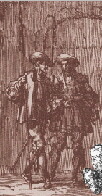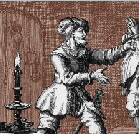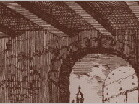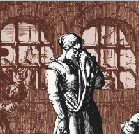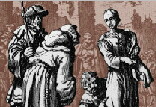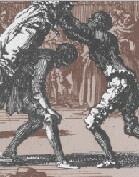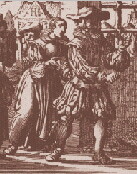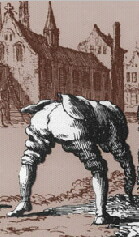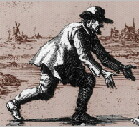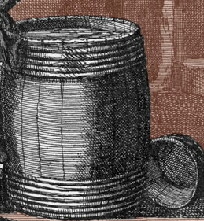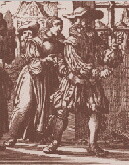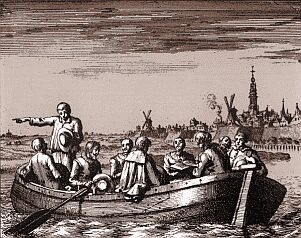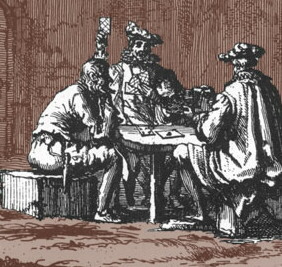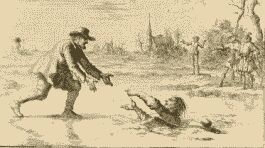
Brother Dirk
and Other Stories
adapted and arranged for my nieces and nephews
by Michael McGinnis
from Martyrs' Mirror
by Thieleman J. Van Braght and others
Illustrations by Jan Luykens
modified by Third Way Cafe
Biographiks
Waring, Texas
© 2000, Michael McGinnis.
Table of Contents
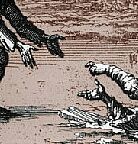
Preface for Parents
This book is about a group of Christians who were not afraid to share what they had found: that God wanted more for His people than they
had ever imagined. As a result, they were criticized and persecuted by church and state. Though it cost the lives of thousands of them, they were rewarded with a glimpse of the glory
of God's original plan for His Church. They did not serve a weak God.
Living 450 years ago, and called Anabaptists by their enemies because they insisted only believers
could be baptized, this movement may have included as many as one-tenth of
Holland and Belgium, in spite of threats of torture and execution from
their Spanish rulers.
This book retells some of the stories of these rare believers from Martyr's Mirror, the Anabaptist classic published in 1660 by
Thieleman J. van Braght, a hundred years after the worst persecutions. By the 17th century, Holland had shaken off the yoke of Spain, and
had become one of the most prosperous nations on earth. Pastor van Braght saw that his fellow Anabaptists
were sinking back into the complacency their spiritual forefathers had left. In this sense, his day
greatly resembles our own. Today his book is a traditional Mennonite or Amish wedding gift, but
few have read it all the way through.
Illustrations come from the original etchings by Jan Luykens, who, like van Braght, was a 17th century Dutch Anabaptist pastor and writer who also
illustrated a classic edition of Pilgrim's Progress.
People might laugh at me for attempting to make a children's book from a thousand-page tome in
which most of the characters are killed. But from the first time I began to read the story of Dirk
Willems, and my nieces and nephews immediately became silent (which doesn't happen naturally), I
knew something special was happening. As they began to clamor for another story about the
"Brother Dirk people" every time I got into their van for a trip, I realized to my surprise that this
must be a story for children after all. In fact, I ran out of time and room to tell all the interesting tales
contained in the original book. You will have to wait for a second edition or second volume if you
want to hear about pirates, dungeons, bumbling priests, tearful farewells, and more clever escapes.
Of course, in this book, I've made accommodations to my youngest readers. Every section helps explain the
others, and hopefully each one is fun to read, but if your children prefer to skip some of them after
the first time and repeat their favorites, that's fine. Many names and places have been changed, not
to protect the innocent, but simply to make them easier to pronounce! I figured even a ten or twelve year old
would do better with names like Haddie or Maria than Hadenwijk or Maeyken. (However, if you're interested, Jans
should be pronounced like Yonce; Willems should be pronounced like Villums.) And like soup, I've
condensed the stories and dialogues, combining interesting details from several different people into
a single narrative. I've condensed time and space too, changing the facts making it appear that most
of the characters lived and knew each other in the Flemish town of Meenen, which isn't true. In fact,
the original stories span about fifty years.
More importantly for the children, I've tried to limit references to violence and bloodshed. Though
I'm writing about martyrs, I've tried to get as many safely out of jail as possible! I've used the words
"torture" and "execution," but haven't included any details. But for your information, many of these
Anabaptists were executed like Joan of Arc. You can decide whether to tell your child what that
means. In other cases, that method of execution was reserved for pastors and teachers, or for those
who refused to recant. Often, laymen died like Louis XVI and laywomen died like Virginia Woolf.
Many Anabaptists were tortured on the rack during interrogations. You can decide whether to tell
your child what a "rack" does. And though most of these martyrs suffered at the hands of a
particular world-wide church, I never name it. The greatest danger to our souls today is not a
particular denomination, but any religious tradition relying on state support that intertwines itself
with the world system. So I call it simply the state church.
Convinced that we desperately need to drag ourselves from a slumber which rapidly looks more and
more like death, I offer this book as a window, a mirror that reflects the lives of some who truly
knew what life is.
Michael McGinnis
December 2000
Contents
 Begin
Begin
